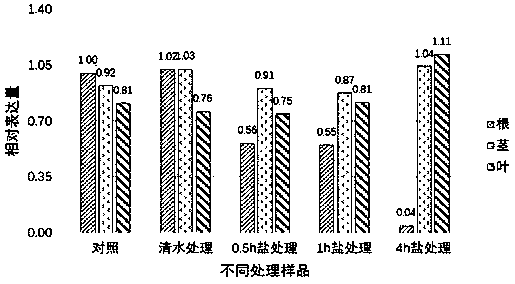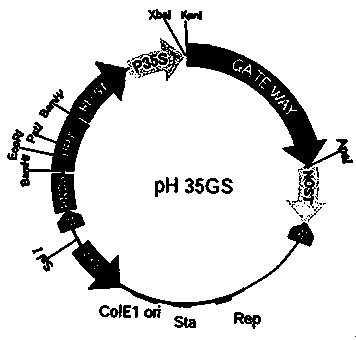A key gene tcarf6 of Tamarix salt stress response and its application
A key gene, salt stress technology, applied in tamarisk salt stress response key gene TcARF6 and its application field
- Summary
- Abstract
- Description
- Claims
- Application Information
AI Technical Summary
Problems solved by technology
Method used
Image
Examples
Embodiment 1
[0020] 1. Cloning of TcARF6 gene by RACE technology
[0021] Based on the existing results of tamarix salt stress transcriptome sequencing research, RACE primers at the 5' and 3' ends were designed to obtain corresponding PCR products, cloned into T-vectors, and sequenced after positive screening of the inserted fragments. The sequence of the sequencing results passed The overlapping regions were spliced to obtain the full-length cNDA. RNA derived from
[0022] TcARF6 RACE primers:
[0023] RACE Adapter contains a uniquely designed Adapter Primer sequence (5'-CTAATACGACTCACTATAGGGCAAGCAGTGGTATCAACGCAGAGT-3') to facilitate primer design.
[0024] 3'RACE Forward Primer:
[0025] Outer Primer: 5'-TACAGCATCCTCAACAGCAAATGGT-3';
[0026] Inner Primer: 5'-TAGACATGGTTGGTACAGACTC-3';
[0027] 3'RACE reverse primer:
[0028] Outer Primer: 5'-CTAATACGACTCACTATAGGGCAAGCAGTGGTATCAACGCAGAGT-3';
[0029] Inner Primer: 5-'CTAATACGACTCACTATAGGGC-3';
[0030] 5'RACE Forward Primer:
...
Embodiment 2
[0076] The response of TcARF6 gene to salt stress was verified by fluorescent quantitative PCR technology. Fluorescent quantitative PCR primers were designed based on the ORF region of TcARF6 gene, and internal reference primers were designed based on the TIFY gene of Tamarix chinensis. The sequence is as follows:
[0077] TcARF6 forward primer: 5'-TCTGGGCATTCGGCGAGCTA-3';
[0078] TcARF6 reverse primer: 5'-GCGGCTATTTGTCGCTGCTG-3';
[0079] TIFY forward primer: 5'-TGGAGTAACTGAACCAGGGAGGAG-3';
[0080] TIFY forward primer: 5'-GGCTGTAGGTGCCTGAACTGG-3'.
[0081] Utilize saturating dye evagreen (Biotium company) and fluorescence quantitative PCR instrument Viia7 (ABI company) to detect the fluorescence intensity of the PCR process in real time. The specific PCR system refers to the instructions of evagreen, and calculates and determines by comparing the cycle number of the TcARF6 gene and the internal reference that reach the fluorescence threshold. Relative expression of TcARF6...
Embodiment 3
[0082] Embodiment 3 TcARF6 gene plant expression vector construction
[0083] The overexpression vector of TcARF6 gene was constructed by gateway technology. Using specific PCR primers (TcARF6ORF primers), cDNA was used as a template to carry out PCR amplification, and the TcARF6 gene ORF was constructed into the entry vector. The entry vector was pCRTM8 / GW / TOPOTM vector (Invitrogen). The reaction system is: Fresh PCR product (purified) 10-20ng; Salt solution 1μL; pCRTM8 / GW / TOPOTM vector 1μL; add sterile ddH 2 O to make up 6 μL. The reaction procedure is: stand at room temperature for 30 min.
[0084] Pick positive clones from the screening culture plate for PCR detection and sequencing verification, the entry vector with TcARF6 gene and the plant expression vector pH35GS for LR reaction. Vector plasmid such as figure 2shown. The reaction system is: linearized dentry clone 100ng; purified destination vector (100ng / μL) 1.5μL; LR Clonase IIenzyme mix 2μL; add TE (pH 8.0) ...
PUM
 Login to View More
Login to View More Abstract
Description
Claims
Application Information
 Login to View More
Login to View More - R&D
- Intellectual Property
- Life Sciences
- Materials
- Tech Scout
- Unparalleled Data Quality
- Higher Quality Content
- 60% Fewer Hallucinations
Browse by: Latest US Patents, China's latest patents, Technical Efficacy Thesaurus, Application Domain, Technology Topic, Popular Technical Reports.
© 2025 PatSnap. All rights reserved.Legal|Privacy policy|Modern Slavery Act Transparency Statement|Sitemap|About US| Contact US: help@patsnap.com


